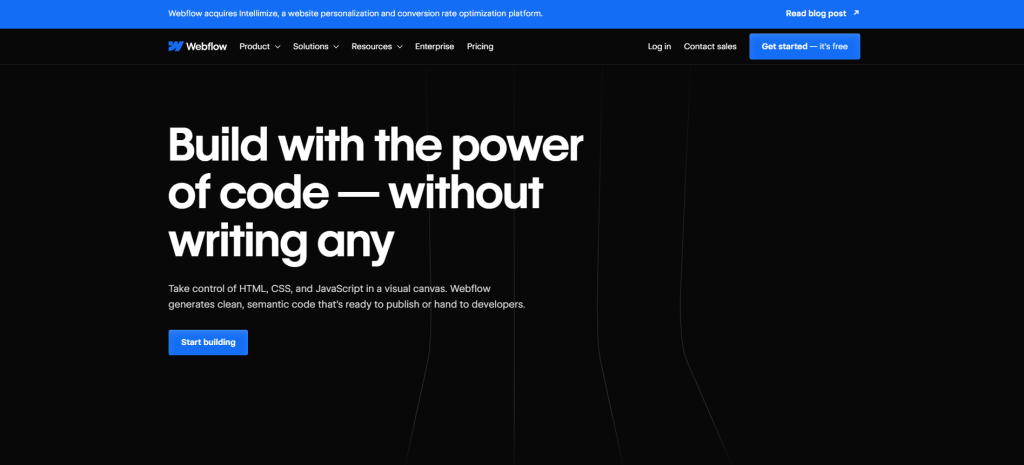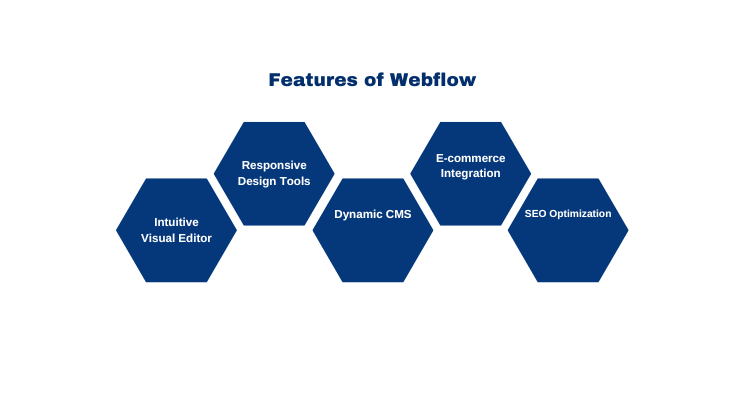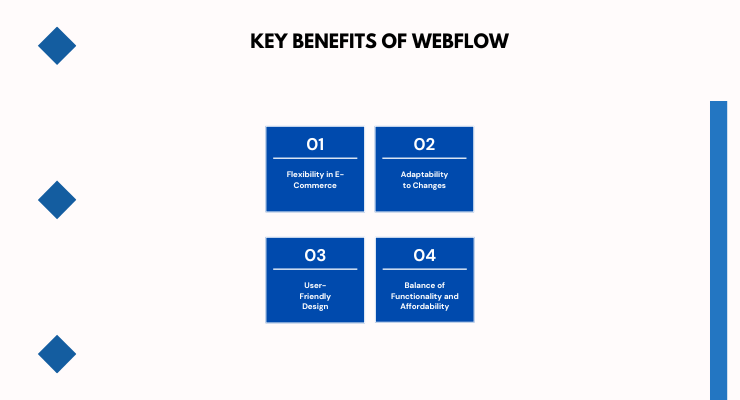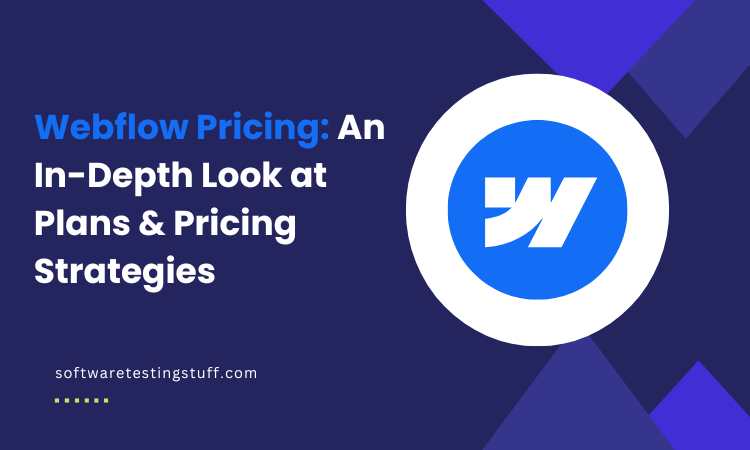Webflow has emerged as a significant force in the website building and hosting market. It offers a unique blend of design flexibility and powerful features. Understanding Webflow’s pricing is essential for anyone considering this platform, from individual creative to large businesses.
The pricing structure of Webflow is diverse, accommodating a wide range of needs and budgets. In this article, we will delve into the specifics of Webflow pricing, highlighting its relevance in the current market and why comprehending its cost structure is vital.
Whether you’re a freelancer, a growing business, or a large enterprise, this exploration will clarify how Webflow can fit into your financial planning and digital strategy.
Webflow: A Quick Overview

Webflow is a modern web design tool and hosting platform launched in 2013. It was created to empower designers to build professional, responsive websites without needing to write code.
At its core, Webflow combines a visual design interface with powerful CMS (Content Management System) and hosting capabilities. The main purpose of Webflow is to simplify the process of designing and launching websites.
It’s particularly appealing to designers, freelancers, and businesses that want the freedom to create custom websites without deep technical expertise. Webflow allows users to design a website visually while generating clean, semantic code in the background.
However, Webflow’s target audience includes graphic and web designers and small to medium-sized businesses. It’s also increasingly popular among larger organizations looking for a more streamlined, code-free approach to web design. With Webflow, users can swiftly move from a concept to a fully functional website, making it a valuable tool in today’s digital landscape.
Features of Webflow

Webflow stands out with its features catering to both design enthusiasts and professionals. Here are five key features, including aspects related to Webflow pricing plans, that highlight its versatility:
Intuitive Visual Editor
Webflow’s visual editor is a game-changer. It allows you to design custom layouts visually, eliminating the need for coding. This makes it ideal for designers who value a visual approach to website creation.
Responsive Design Tools
The platform ensures your website is automatically optimized for any device, a crucial feature in today’s mobile-first world. This responsiveness is seamlessly integrated into Webflow’s design interface.
Dynamic CMS
Webflow integrates CMS capabilities directly into its platform. You can manage and publish content easily, a feature that simplifies the web development process and is included in various Webflow pricing plans.
E-commerce Integration
Webflow offers comprehensive e-commerce tools. These are integrated with the design tools, making it easier to set up a store using Webflow pricing templates.
SEO Optimization
Webflow includes built-in SEO tools, allowing you to optimize your site for search engines directly from the platform. This feature is essential for increasing online visibility and is a part of the Webflow pricing table considerations.
Key Benefits of Webflow

Webflow’s benefits extend beyond its design capabilities, particularly when considering Webflow pricing explained. It offers the following advantages:
Flexibility in E-Commerce
Webflow shines in its e-commerce capabilities, offering flexible options suitable for various business sizes. The Webflow pricing ecommerce plan accommodates various online store requirements, making it a versatile choice for retailers.
Adaptability to Changes
The platform is known for its adaptability, including how it handles Webflow pricing changes. Even with occasional pricing increases, Webflow continually adds new features and enhancements, ensuring users get value for their investment.
User-Friendly Design
Webflow’s user-friendly interface is a major benefit, allowing individuals without technical skills to create professional websites. This ease of use is a significant advantage, particularly when considering Webflow pricing explained.
Balance of Functionality and Affordability
Overall, Webflow strikes an excellent balance between functionality and affordability. The platform offers different features and tools that cater to both novice and professional users, making it a valuable tool for diverse web design needs.
Webflow Pricing Breakdown
(Note for Designers – The image will be an Infographics)
Webflow presents a variety of pricing plans, each designed to cater to different needs, from individual hobbyists to large enterprises. Here’s a detailed look at each plan and its suitability:
Starter (Free)
The Starter plan, offered for free, includes the following features:
- A Webflow.io domain, ideal for personal projects or experimentation.
- It can create up to 2 pages, perfect for small, simple sites.
- Allows for 50 CMS items, suitable for basic content management needs.
- Includes 50 form submissions (lifetime), enough for minimal user interaction.
- Comes with 1 GB bandwidth, catering to limited traffic.
- Offers localization and a free preview feature.
- Designed for up to 1,000 visitors, making it ideal for small-scale, personal projects or testing Webflow’s features.
Basic ($14/mo, billed yearly)
The Basic plan provides:
- A custom domain is lending a professional touch to your site.
- It can go up to 150 pages, suitable for more comprehensive websites.
- 500 form submissions per month, catering to moderate user interaction.
- A generous 50 GB bandwidth, accommodating moderate site traffic.
- This plan best suits relatively simple, static sites that don’t require a content management system.
CMS ($23/mo, billed yearly)
The CMS plan includes:
- A custom domain for a more branded experience.
- Capacity for 150 pages, allowing for content-rich sites.
- 2,000 CMS items, ideal for blogs or sites heavy on content.
- 1,000 form submissions per month, supporting active user engagement.
- 200 GB bandwidth, handling a good amount of site traffic.
- 3 content editors, site search, and localization features enhance the content management experience.
- Suitable for sites with up to 250,000 visitors, making it perfect for blogs or content-driven sites.
Business ($39/mo, billed yearly)
The Business plan offers:
- A custom domain to maintain brand identity.
- Up to 150 pages, supporting large and complex sites.
- 10,000 CMS items, catering to extensive content needs.
- 2,500 form submissions per month, ideal for high user interaction.
- A significant 400 GB bandwidth, accommodating high traffic volumes.
- 10 content editors, advanced site search, and form file upload features.
- This plan is best for larger sites that require more robust CMS capabilities and can handle up to 300,000 visitors.
Enterprise (Contact for Pricing)
The Enterprise plan is tailored for large-scale business needs and includes:
- Unlimited user accounts provide flexibility for large teams.
- Features for advanced collaboration and guaranteed service level agreements (SLAs).
- Enhanced enterprise-grade security and dedicated customer success support.
- This plan is ideal for businesses requiring a comprehensive, enterprise-level web solution with customized support and features.
When Should I Pay for Webflow?
Paying for Webflow becomes essential when your website’s needs surpass the offerings of the free plan, especially in scenarios like e-commerce expansion, increased traffic, and the requirement for more advanced website functionalities.
Understanding Webflow’s Pricing Plans
When you start feeling constrained by the limitations of Webflow’s free plan, it’s time to consider their paid options. Understanding Webflow pricing plans helps you recognize when additional features become necessary for your growing website.
Scaling Up with Webflow Ecommerce
For those running online stores, Webflow pricing ecommerce plans provide specialized features tailored to e-commerce needs. As your store expands, these plans offer the tools required for a smooth and efficient online selling experience.
Meeting Increased Traffic Demands
As your website attracts more visitors, the need for higher bandwidth and increased form submissions becomes apparent. Reviewing the Webflow pricing table can guide you to a plan accommodating this growing traffic.
Upgrading for Advanced Features
If your website development involves multiple content editors or requires advanced functionalities like site search, it’s time to look at higher-tier Webflow plans. These plans offer more comprehensive features suited for complex website needs.
Responding to Webflow Pricing Changes
Stay informed about any Webflow pricing change or increase. Sometimes, these changes bring additional features that might benefit your website, justifying the upgraded investment.
What are the Best Alternatives to Webflow?
Exploring alternatives to Webflow is essential for finding the right platform that suits your web design and e-commerce needs. Here’s a comparison of Webflow with other popular platforms like Shopify, Wix, and Squarespace:
| Alternative | Pricing Comparison | Detailed Comparison to Webflow |
| Shopify | Generally more expensive, with a focus on e-commerce features. | Shopify stands out as a dedicated e-commerce platform, offering advanced tools and functionalities for online stores, making it ideal for businesses focusing primarily on e-commerce, a contrast to Webflow’s border design focus. |
| Wix | Offers a range of plans, some similar in pricing to Webflow, with various functionality levels. | Wix is known for its user-friendly drag-and-drop feature and a wide variety of templates, catering to those who prioritize design flexibility and customization, similar to Webflow but with a slightly different user interface approach. |
| Squarespace | Pricing is competitive with Webflow, offering a balance of features and cost. | Squarespace is renowned for its sleek templates and intuitive design interface, making it a strong competitor to Webflow for users seeking an easy-to-use platform with a strong focus on aesthetics and user experience. |
Final Note
Deciding whether Webflow is a suitable investment for you hinges significantly on understanding Webflow pricing and how it aligns with your project’s needs. Webflow offers a powerful blend of design tools and functionalities, making it a compelling option for many.
Yet, assessing whether the cost fits your budget and the platform’s features meet your specific requirements is crucial. Consider alternatives like Shopify, Wix, or Squarespace if your priorities are different aspects of web development.
Take the time to explore and understand Webflow pricing thoroughly to ensure that your decision not only meets your design needs but also stays within your financial boundaries.
Frequently Asked Questions
Does Webflow have pricing plans for teams and agencies?
Yes, Webflow provides specific plans designed for teams and agencies, offering collaborative features and advanced site capabilities to meet the demands of team-based projects and client work.
Are there any transaction fees with Webflow’s ecommerce plans?
Webflow’s ecommerce plans do include transaction fees, but these vary based on the chosen plan. Reviewing the specific details for each e-commerce plan regarding transaction fees is advisable.
Can I switch between Webflow plans easily?
Users can easily upgrade or downgrade between Webflow plans. This flexibility allows for adjustments based on changing business needs or project scales.
Does Webflow offer any discounts for annual subscriptions?
Webflow often provides discounts for users who choose annual billing over monthly. These discounts can make higher-tier plans more accessible and cost-effective in the long run.
- Top 10 Cross Browser Testing Tools: The Best Choices for 2024 - October 28, 2025
- 5 Best API Testing Tools: Your Ultimate Guide for 2024 - October 26, 2025
- Top 5 Regression Testing Tools: Comprehensive Review & Guide - October 26, 2025
